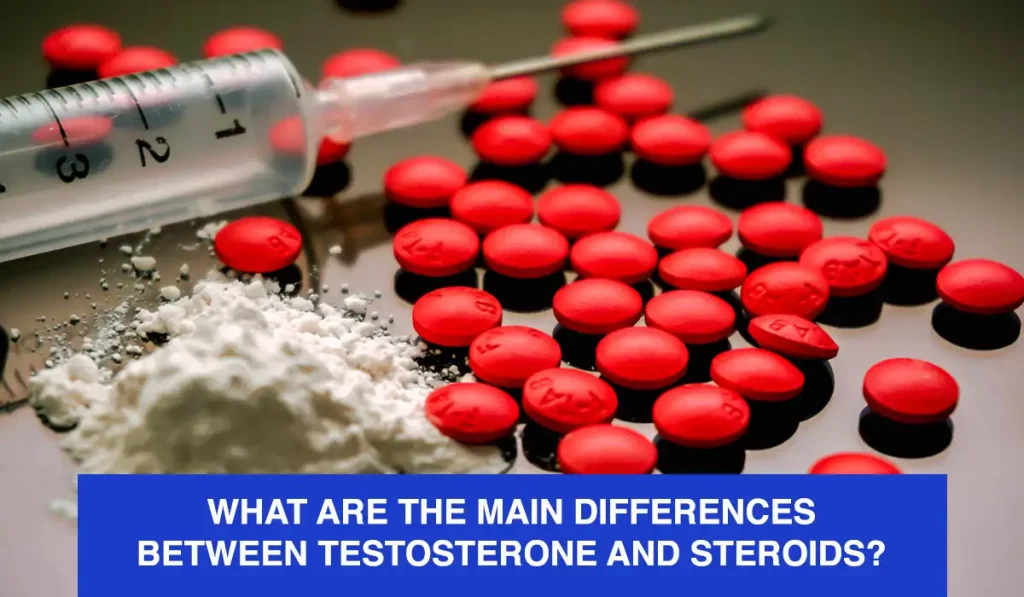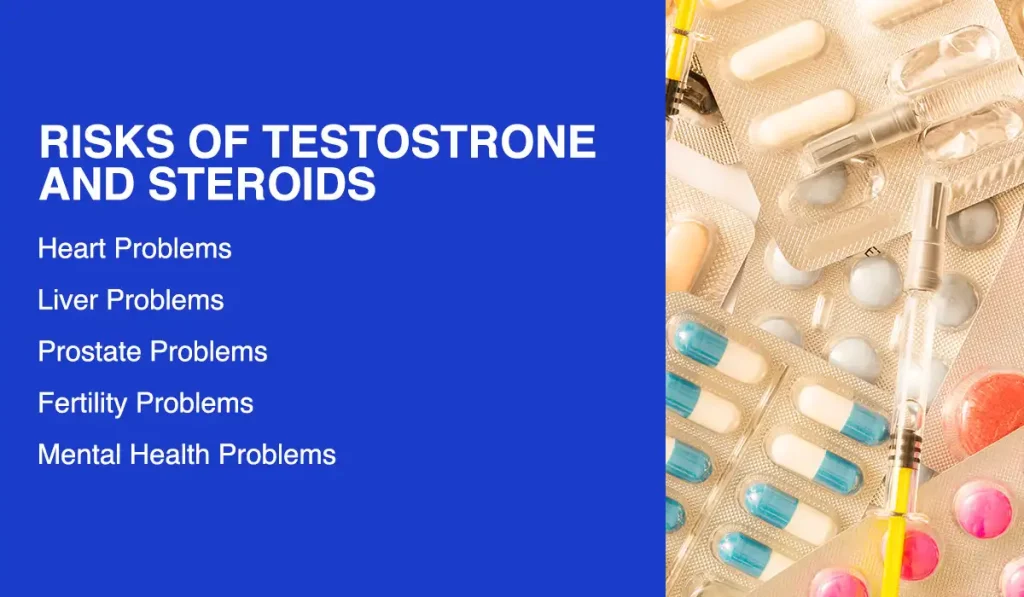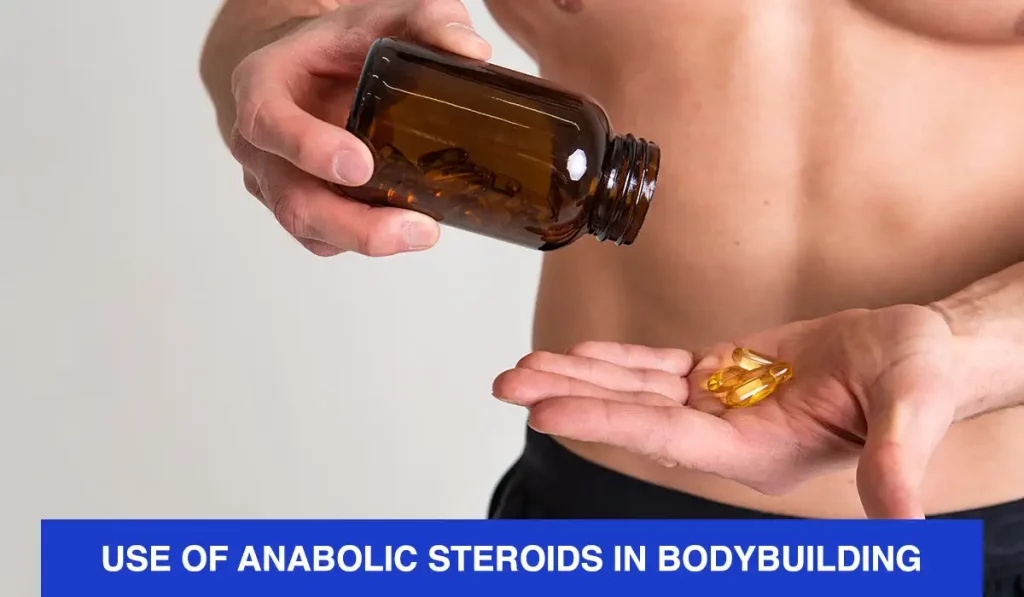FREE SHIPPING ON ORDERS $99+ | SAME DAY SHIPPING ON ORDERS PLACED BEFORE 12PM PST
Testosterone Vs Anabolic Steroids: Difference Between Testosterone and Anabolic Steroids
Contents
- Quick Comparison of Testosterone Vs Steroids
- What is Testosterone?
- What Are Steroids?
- Is Testosterone Replacement Therapy the Same as Steroids?
- What Are the Main Differences Between Testosterone and Steroids?
-
Use of Testosterone Esters in Bodybuilding
- Common Testosterone Esters Used by Pro Bodybuilders
- Muscle Growth and Strength Enhancement
- Cutting and Weight Loss
- Use of Anabolic Steroids in Bodybuilding
- Purpose in Bodybuilding
- Common Types of Anabolic Steroids Used
- What Are the Functions of Testosterone?
- What is Testosterone Deficiency?
- What Are the Symptoms of Low T?
- Who is Eligible for TRT?
- What Are the Different Types of Steroids Used for Bodybuilding?
- What Are the Benefits of Using Anabolic Steroids for Muscle Growth and Athletic Performance?
- What is Steroid Abuse?
- Final Thoughts
Testosterone is a natural hormone in our bodies that is vital for male development. On the other hand, steroids, specifically anabolic steroids, are synthetic compounds designed to boost muscle growth and athletic performance. Your body tightly regulates testosterone, maintaining a healthy balance, and sometimes, it may need medical help in the form of Testosterone Replacement Therapy (TRT).
TRT is administered under the guidance of healthcare professionals. Steroids, however, are often used without medical supervision, leading to potential health risks like cardiovascular issues, hormonal imbalances, and liver damage. In this blog post, we’ll describe in detail the key differences between Testosterone Replacement Therapy (TRT) and the use of anabolic steroids.
Quick Comparison of Testosterone Vs Steroids
| Aspects | Anabolic steroids | Testosterone |
|---|---|---|
| Origin | Synthetic hormones that mimic testosterone | Natural hormone produced by the testes |
| Potency | Much more potent than testosterone, producing more pronounced effects | Less potent than anabolic steroids, resulting in more subtle effects |
| Duration of action | Longer-acting, with effects lasting for several days or even weeks | Shorter-acting, with effects typically dissipating within 24 hours |
| Primary effects | Enhanced muscle growth, increased strength, and reduced body fat | Maintenance of male sexual characteristics, bone density, and muscle mass |
| Side effects | Increased risk of liver damage, heart problems, certain types of cancer, mood swings, aggression, and stunted growth in adolescents | Increased risk of prostate cancer, sleep apnea, elevated red blood cell count, and skin problems |
| Legal status | Controlled substances, requiring a prescription for medical use | Controlled substances, but with more lenient regulations for therapeutic use |
| Primary purpose | Athletic and bodybuilding performance enhancement | Testosterone replacement therapy (TRT) for individuals with low testosterone levels |
| Dosage | Typically administered in higher doses compared to testosterone | Typically administered in lower doses compared to anabolic steroids |
| Duration of treatment | Often used in cycles or periods of intense training, followed by off-periods | Typically used on a continuous basis for TRT |
| Illicit use | Widely used illegally by athletes and bodybuilders to enhance performance | Less commonly abused illegally, but still a concern for potential misuse |
What is Testosterone?
Testosterone is a hormone predominantly found in males, but also present in females in smaller amounts. It’s vital for many bodily functions such as muscle growth, fat burning, and maintaining energy levels.
Testosterone is significant in the development of male sexual characteristics and plays a role in fertility, muscle mass, and fat distribution. It’s also used medically in testosterone replacement therapy (TRT) to treat men with low testosterone levels, improving aspects like libido and overall well-being.
Learn more about Testosterone Esters for bodybuilding here: Best Testosterone Esters for Muscle Gain and Fat Burning
What is TRT?
Testosterone Replacement Therapy (TRT) is a medical treatment primarily used to address low testosterone levels in men. This therapy involves administering testosterone to compensate for the reduced natural production of the hormone. TRT aims to bring testosterone levels back to a normal range, which can lead to improvements in libido, energy levels, muscle strength, mood, and overall well-being.
TRT has gained a lot of popularity recently among bodybuilders and fitness influencers. It has less side effects than anabolic steroids and SARMs. In addition, you can take TRT from clinics with a doctor’s recommendation legally.
What Are Steroids?
Anabolic Androgenic Steroids (AAS) are synthetic substances that mimic the properties of the naturally occurring male sex hormone testosterone. These compounds are designed to promote muscle growth (anabolic effects) and the development of male sexual characteristics (androgenic effects).
According to research by Shalender Bhasin,” By mimicking the effects of testosterone, these compounds promote the development of lean muscle mass. It makes them a sought-after aid among bodybuilders and athletes looking to achieve significant gains in strength and size.
AAS are used in various medical contexts but are more famously known for their use in enhancing muscle mass and strength, particularly in the context of bodybuilding and athletic performance enhancement.
Read more: Best Steroids for Bodybuilding in Canada
Is Testosterone Replacement Therapy the Same as Steroids?
Testosterone Replacement Therapy (TRT) and anabolic steroids, while related, are not the same. TRT is a medical treatment for low testosterone levels, while anabolic steroids are used for athletic performance enhancement. TRT is administered in lower doses and is generally well-tolerated, while anabolic steroids can cause serious side effects.
TRT is prescribed by a healthcare provider, while anabolic steroids are controlled substances and illegal for non-medical use.
Read more: TRT vs Anabolic Steroids
What Are the Main Differences Between Testosterone and Steroids?

Origin and Potency
- Steroids are synthetic hormones that are much more potent than testosterone, the natural hormone produced by the testes in males. Steroids are attractive to athletes and bodybuilders seeking rapid muscle growth and increased strength.
- Testosterone is a hormone primarily associated with the development and maintenance of male characteristics and overall male health. It plays a crucial role in male sexual development and maintains male sexual characteristics.
Nature
- Testosterone is a naturally occurring hormone, primarily in males but also in small amounts in females.
- Steroids encompass a broader range of organic compounds, which includes both natural hormones like testosterone and synthetic substances.
Function
- Testosterone primarily functions as a male sex hormone, influencing sexual development, muscle mass, and bone density.
- Steroids have a wider range of functions. For instance, anabolic steroids (similar to testosterone) promote muscle growth, while corticosteroids are used for their anti-inflammatory and immunosuppressant properties.
Usage
- Testosterone is used in medical treatments for testosterone deficiency, and certain breast cancers, and to aid puberty in boys with delayed puberty. It is also misused for performance enhancement.
- Steroids are used for a variety of medical purposes, such as treating autoimmune diseases, allergies, and asthma (corticosteroids), and for muscle gain and performance enhancement (anabolic steroids).
Regulation and Legal Status
- Testosterone is a controlled substance in many countries, regulated due to its potential for abuse, particularly in sports.
- Steroids as a group are also regulated, with specific laws around the use of anabolic steroids due to their potential for abuse and health risks.
Illicit Use
- Steroids are widely used illegally by athletes and bodybuilders to enhance performance beyond what is naturally possible. This illicit use can lead to severe health consequences and is strongly discouraged.
- Testosterone abuse is less common than steroid abuse, but it still poses concerns. Some individuals may misuse testosterone without a prescription or exceed prescribed dosages in an attempt to enhance athletic performance or physical appearance. This misuse can also lead to adverse health effects.
Effects of Testosterone and Steroids
- Muscle Growth
- Testosterone: Increases muscle growth through neurotransmitters and DNA interaction, promoting protein synthesis.
- Steroids: Swiftly enhance muscle strength, allowing more intensive and prolonged training, leading to rapid lean muscle tissue gains.
- Strength
- Testosterone: Increases muscle mass, controls weight, and boosts energy. Treatment for low levels reduces fat and enhances muscle size and strength.
- Steroids: Enable rapid gain in muscle strength, improving training capacity and recovery.
- Bone Density
- Testosterone: Supports muscle and bone health, with low levels increasing osteoporosis risk.
- Steroids: Can cause bone loss and osteoporosis, with high doses leading to rapid bone loss.
- Sex Drive
- Testosterone: Supplements can improve sex drive if low levels are the cause.
- Steroids: May increase sexual confidence and desire but can also reduce sex drive, cause erection issues, and lead to testicle shrinkage.
- Mood
- Testosterone: Helps maintain a balanced mood and quality of life.
- Steroids: Can lead to negative mood effects like anger, aggression, depression, and “Roid Rage.”
- Other Effects
- Testosterone: Affects the development of male sex organs, voice deepening, and hair growth.
- Steroids: Can cause severe damage, including heart issues, strokes, tumours, kidney problems, and mental health issues.
Risks of Testosterone and Steroids

- Heart Problems
- Testosterone: Supplements come with a risk of heart attack and stroke.
- Steroids: Can cause heart attacks, especially when misused or in high doses, and may affect heart function and structure.
- Liver Problems
- Testosterone: Low levels can lead to VAT buildup, insulin resistance, and inflammation in the liver.
- Steroids: Risk of liver damage, ranging from enzyme elevations to severe conditions like cholestasis and liver tumors.
- Prostate Problems
- Testosterone: Treatment may increase prostate size and affect urine flow but doesn’t raise prostate cancer risk.
- Steroids: Do not directly impact the prostate but are linked to other risks like heart and liver issues.
- Fertility Problems
- Testosterone: Supplementation can reduce sperm production and cause testicular shrinkage, affecting fertility.
- Steroids: Significantly lower sperm counts, leading to infertility.
- Mental Health Problems
- Testosterone: Low levels can lead to sadness, depression, memory issues, and low motivation.
- Steroids: Associated with anxiety, mood disorders, mania, hypomania, and major depression, especially at high doses.
- Other Risks
- Testosterone: May worsen sleep apnea, cause acne, hormonal imbalances, and prostate issues.
- Steroids: Can cause severe damage like heart attacks, strokes, liver tumors, kidney failure, psychiatric issues, and depression, often leading to resumed use after stopping.
Learn more about adverse effects of Testosterone shots: Side Effects of Testosterone Injections
Use of Testosterone Esters in Bodybuilding
Professional bodybuilders often use various testosterone esters as part of their training regimen to enhance muscle growth, increase strength, and aid in cutting weight. Testosterone esters are a form of synthetic testosterone, where the testosterone molecule is bonded to an ester to delay its release into the bloodstream. This modification allows for different absorption rates and half-lives, affecting how quickly and for how long the testosterone acts in the body.
Common Testosterone Esters Used by Pro Bodybuilders
- Testosterone Enanthate:
- A slow-releasing ester with a half-life of about 7-10 days.
- Often used in bulking phases for steady muscle growth.
- Testosterone Cypionate:
- Similar to enanthate with a slightly longer half-life.
- Preferred for its longer duration, reducing the frequency of injections.
- Testosterone Propionate:
- Fast-acting ester with a short half-life of about 2-3 days.
- Used for shorter cycles or for fine-tuning muscle gains towards the end of a longer cycle.
- Sustanon:
- A blend of four different testosterone esters.
- Provides both immediate and long-lasting testosterone release.
Muscle Growth and Strength Enhancement
- Testosterone esters promote anabolic effects in the body, significantly enhancing protein synthesis and nitrogen retention in muscles.
- This leads to increased muscle mass and strength, essential for competitive bodybuilding.
- The choice of ester depends on the phase of training, desired speed of results, and personal response to different esters.
Cutting and Weight Loss
- While primarily known for muscle growth, testosterone also plays a role in fat loss.
- It can improve metabolic rate and aid in the more efficient burning of body fat.
- During cutting phases, bodybuilders might adjust dosages or switch esters to maintain muscle mass while losing fat.
Use of Anabolic Steroids in Bodybuilding

The use of anabolic steroids in bodybuilding is a significant and controversial aspect of the sport. Anabolic steroids are synthetic substances that mimic the effects of the male hormone testosterone. They are known for their potent effects on muscle growth, strength enhancement, and physical performance, making them appealing to bodybuilders and athletes.
Purpose in Bodybuilding
- Muscle Mass Increase: Anabolic steroids significantly enhance protein synthesis in muscle cells, leading to increased muscle size and strength.
- Recovery Time Reduction: They help in reducing recovery time after intense workouts, allowing bodybuilders to train harder and more frequently.
- Fat Loss: While their primary role is not fat burning, anabolic steroids can aid in reducing body fat, which is crucial during the cutting phase.
- Enhanced Physical Performance: Improved strength and stamina enable athletes to push beyond their natural limits.
Common Types of Anabolic Steroids Used
- Dianabol: Popular for rapid muscle mass gain.
- Anavar: Known for providing strength and is relatively more suitable for cutting.
- Trenbolone: Extremely potent for both bulking and cutting.
- Deca Durabolin: Used for its quality muscle growth and strength features.
- Winstrol: Commonly used during cutting phases for its fat reduction qualities.
FAQs
What Are the Functions of Testosterone?
Testosterone contributes to the development of lean body mass, aiding in weight control and boosting energy levels. For men with low testosterone, studies have indicated that treatment can lead to a decrease in fat mass while simultaneously increasing muscle size and strength. These functions highlight the essential role of testosterone in achieving significant gains in bodybuilding.
What is Testosterone Deficiency?
Testosterone Deficiency refers to an inadequate production of testosterone, the primary male hormone. This condition is more commonly associated with older men but can affect younger individuals due to various factors. It can manifest as a range of symptoms, including fatigue, reduced muscle mass, and changes in mood and libido.
What Are the Symptoms of Low T?
The symptoms of low testosterone can encompass several aspects of a person’s life. These may include reduced energy levels, muscle weakness, body hair loss, tiredness, obesity and even cognitive changes.
Physically, low testosterone can result in decreased muscle mass, increased body fat, and possible erectile dysfunction. Identifying and addressing these symptoms is vital, as low testosterone can significantly affect one’s overall quality of life and well-being.
Who is Eligible for TRT?
Testosterone Replacement Therapy (TRT) is primarily intended for males diagnosed with hypogonadism. This diagnosis is confirmed through blood tests indicating low testosterone levels, typically below 300 nanograms per deciliter (ng/dl). Accurate assessment by a healthcare professional is essential to determine eligibility for TRT.
What Are the Different Types of Steroids Used for Bodybuilding?
Seven different types of steroids are prevalent in bodybuilding
- Trenbolone
- Oxymetholone
- Methandrostenolone
- Nandrolone
- Stanozolol
- Boldenone
- Oxandrolone
What Are the Benefits of Using Anabolic Steroids for Muscle Growth and Athletic Performance?
Anabolic Steroids can significantly accelerate muscle development, leading to increased size, strength, and endurance. Anabolic steroids also aid in faster recovery after intense workouts, allowing athletes to train more frequently.
They enhance protein synthesis, promoting muscle repair and growth. Additionally, steroids can boost red blood cell production, increasing oxygen delivery to muscles for improved performance.
What is Steroid Abuse?
Steroid abuse refers to the misuse and excessive consumption of anabolic steroids, often for non-medical purposes. Many individuals, including athletes and bodybuilders, abuse steroids to gain a competitive edge and achieve rapid muscle growth and performance enhancements.
It often involves taking doses far above recommended levels, posing significant health risks. Steroid abuse can lead to various adverse effects, including liver damage, cardiovascular issues, mood swings, and addiction.
Read more about the side effects of Anabolic Steroids here: Side Effects of AAS
Final Thoughts
Testosterone is a natural hormone essential for the body’s functions, while steroids are synthetic compounds designed for muscle growth and performance enhancement. Testosterone replacement therapy (TRT) is a medical treatment for low testosterone levels prescribed by healthcare professionals.
Anabolic steroids, on the other hand, are often used for muscle building and athletic gains, but they come with serious health risks. It’s crucial to recognize the distinction and use steroids, if ever, under professional guidance, considering the potential consequences.
Don’t forget to check out our AAS shop page for more safe buying options.
Sources
- Justin M Johnson, Lisa B Nachtigall, Theodore A Stern (September 7, 2013) The effect of testosterone levels on mood in men: a review
- Avni Mody Donna White, Fasiha Kanwal, and Jose M Garcia (September 1, 2015) Relevance of low testosterone to non-alcoholic fatty liver disease
- Ahmad Al-Qudimat, Raed M. Al-Zoubi, Aksam A. Yassin, Mustafa Alwani, Omar M. Aboumarzouk, Khaled AlRumaihi, Raidh Talib, and Abdulla Al Ansari (August 9, 2021) Testosterone treatment improves liver function and reduces cardiovascular risk: A long-term prospective study
- S A Wemyss-Holden, F C Hamdy, K J Hastie (October 4, 1994) Steroid abuse in athletes, prostatic enlargement and bladder outflow obstruction–is there a relationship?
- Jason E. Michaud, Kevin L. Billups, and Alan W. Partin (December 6, 2015) Testosterone and prostate cancer: an evidence-based review of pathogenesis and oncologic risk
Our dedication to unbiased and meticulously tested bodybuilding supplement recommendations has solidified our position as the most trusted resource in the Canadian bodybuilding community.
Our rigorous editorial process ensures that only the most effective and thoroughly evaluated supplements receive our endorsement.
